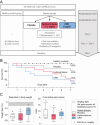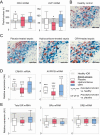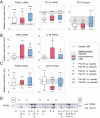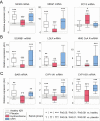Impact of Hydrocortisone and of CRH Infusion on the Hypothalamus-Pituitary-Adrenocortical Axis of Septic Male Mice
- PMID: 34698826
- PMCID: PMC8599906
- DOI: 10.1210/endocr/bqab222
Impact of Hydrocortisone and of CRH Infusion on the Hypothalamus-Pituitary-Adrenocortical Axis of Septic Male Mice
Abstract
Purpose: Sepsis is hallmarked by high plasma cortisol/corticosterone (CORT), low adrenocorticotropic hormone (ACTH), and high pro-opiomelanocortin (POMC). While corticotropin-releasing hormone-(CRH) and arginine-vasopressin (AVP)-driven pituitary POMC expression remains active, POMC processing into ACTH becomes impaired. Low ACTH is accompanied by loss of adrenocortical structure, although steroidogenic enzymes remain expressed. We hypothesized that treatment of sepsis with hydrocortisone (HC) aggravates this phenotype whereas CRH infusion safeguards ACTH-driven adrenocortical structure.
Methods: In a fluid-resuscitated, antibiotics-treated mouse model of prolonged sepsis, we compared the effects of HC and CRH infusion with placebo on plasma ACTH, POMC, and CORT; on markers of hypothalamic CRH and AVP signaling and pituitary POMC processing; and on the adrenocortical structure and markers of steroidogenesis. In adrenal explants, we studied the steroidogenic capacity of POMC.
Results: During sepsis, HC further suppressed plasma ACTH, but not POMC, predominantly by suppressing sepsis-activated CRH/AVP-signaling pathways. In contrast, in CRH-treated sepsis, plasma ACTH was normalized following restoration of pituitary POMC processing. The sepsis-induced rise in markers of adrenocortical steroidogenesis was unaltered by CRH and suppressed partially by HC, which also increased adrenal markers of inflammation. Ex vivo stimulation of adrenal explants with POMC increased CORT as effectively as an equimolar dose of ACTH.
Conclusions: Treatment of sepsis with HC impaired integrity and function of the hypothalamic-pituitary-adrenal axis at the level of the pituitary and the adrenal cortex while CRH restored pituitary POMC processing without affecting the adrenal cortex. Sepsis-induced high-circulating POMC may be responsible for ongoing adrenocortical steroidogenesis despite low ACTH.
Keywords: ACTH; CRH; HPA axis; POMC; hydrocortisone; sepsis.
© The Author(s) 2021. Published by Oxford University Press on behalf of the Endocrine Society.
Figures







Comment in
-
Septic Shock: A Disruptor of the Hypothalamic-Adrenal Axis as We Know It.Endocrinology. 2022 May 1;163(5):bqac010. doi: 10.1210/endocr/bqac010. Endocrinology. 2022. PMID: 35134141 Free PMC article. No abstract available.
Similar articles
-
The role of pro-opiomelanocortin in the ACTH-cortisol dissociation of sepsis.Crit Care. 2021 Feb 16;25(1):65. doi: 10.1186/s13054-021-03475-y. Crit Care. 2021. PMID: 33593393 Free PMC article.
-
Centrally administered murine-leptin stimulates the hypothalamus-pituitary- adrenal axis through arginine-vasopressin.Neuroendocrinology. 2000 Jun;71(6):366-74. doi: 10.1159/000054557. Neuroendocrinology. 2000. PMID: 10878498
-
Alterations in hypothalamic-pituitary-adrenal axis activity and in levels of proopiomelanocortin and corticotropin-releasing hormone-receptor 1 mRNAs in the pituitary and hypothalamus of the rat during chronic 'binge' cocaine and withdrawal.Brain Res. 2003 Feb 28;964(2):187-99. doi: 10.1016/s0006-8993(02)03929-x. Brain Res. 2003. PMID: 12576179
-
Maternal and fetal hypothalamic-pituitary-adrenal axes during pregnancy and postpartum.Ann N Y Acad Sci. 2003 Nov;997:136-49. doi: 10.1196/annals.1290.016. Ann N Y Acad Sci. 2003. PMID: 14644820 Review.
-
Vasopressin and the regulation of hypothalamic-pituitary-adrenal axis function: implications for the pathophysiology of depression.Life Sci. 1998;62(22):1985-98. doi: 10.1016/s0024-3205(98)00027-7. Life Sci. 1998. PMID: 9627097 Review.
Cited by
-
Endocrine and metabolic alterations in response to systemic inflammation and sepsis: a review article.Mol Med. 2025 Jan 21;31(1):16. doi: 10.1186/s10020-025-01074-z. Mol Med. 2025. PMID: 39838305 Free PMC article. Review.
-
Septic Shock: A Disruptor of the Hypothalamic-Adrenal Axis as We Know It.Endocrinology. 2022 May 1;163(5):bqac010. doi: 10.1210/endocr/bqac010. Endocrinology. 2022. PMID: 35134141 Free PMC article. No abstract available.
-
Impact of duration of critical illness and level of systemic glucocorticoid availability on tissue-specific glucocorticoid receptor expression and actions: A prospective, observational, cross-sectional human and two translational mouse studies.EBioMedicine. 2022 Jun;80:104057. doi: 10.1016/j.ebiom.2022.104057. Epub 2022 May 15. EBioMedicine. 2022. PMID: 35584557 Free PMC article.
-
The progress of the microbe-gut-brain axis in sepsis-associated encephalopathy.Front Cell Infect Microbiol. 2025 May 13;15:1587463. doi: 10.3389/fcimb.2025.1587463. eCollection 2025. Front Cell Infect Microbiol. 2025. PMID: 40433666 Free PMC article. Review.
-
Pro-opiomelanocortin and ACTH-cortisol dissociation during pediatric cardiac surgery.Endocr Connect. 2024 Jun 1;13(6):e240078. doi: 10.1530/EC-24-0078. Epub 2024 May 13. Endocr Connect. 2024. PMID: 38657653 Free PMC article.
References
-
- Fleischmann C, Scherag A, Adhikari NK, et al. ; International Forum of Acute Care Trialists . Assessment of global incidence and mortality of hospital-treated sepsis. current estimates and limitations. Am J Respir Crit Care Med. 2016;193(3):259-272. - PubMed
-
- Téblick A, Peeters B, Langouche L, Van den Berghe G. Adrenal function and dysfunction in critically ill patients. Nat Rev Endocrinol. 2019;15(7):417-427. - PubMed
Publication types
MeSH terms
Substances
LinkOut - more resources
Full Text Sources
Medical
Miscellaneous

